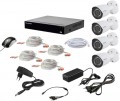Max. capacity
The largest storage capacity with which the recorder is able to work normally.
The more capacious the drive, the higher the processing power of the system in which it is used should be. Therefore, any modern registrar has limitations on disk capacity. However, even in the most modest models, this figure is about 2 TB, in most cases this is quite enough to work with the capabilities provided in this particular registrar.
Camera model
A model of pointed cameras supplied with a video surveillance kit. Knowing this data, you can find detailed information on the cameras and clarify their characteristics. Also, if you buy additional cameras of the same model, you don't have to worry about compatibility.
Matrix size
The physical size of the sensor in the pointed cameras is diagonally, in inches (fractions of an inch).
The larger the sensor, the less prone it is to noise, the better image quality it can provide, and the better it is suited to low light conditions. This is due to the fact that each individual pixel gets more light, because. on a large matrix and individual dots are larger. On the other hand, large matrices are more expensive.
Focal length
Focal length of the lens of pointed cameras included in the set.
The focal length is the distance between the lens and the matrix, at which the image on the sensor is as clear as possible (when the lens is focused to infinity). This indicator directly affects the viewing angles and the degree of magnification: the larger the focal length, the narrower the viewing angle and the more the camera "brings" the object. At the same time, it should be noted that the actual viewing angle is determined not only by the focal length, but also by the size of the matrix (see above). In fact, this means that with different sizes of matrices, lenses with the same focal length will have different working angles. Therefore, only cameras with the same matrix size can be compared with each other according to this indicator.
Horizontal viewing angle
The viewing angle of the directional cameras supplied as standard is horizontal.
Wide viewing angles allow you to cover a large area; this is especially important given that directional cameras are often made stationary. On the other hand, all other things being equal, a larger viewing angle will mean a lower degree of magnification - objects will look smaller, detail will be worse. Therefore, when choosing according to this parameter, you should proceed from what is more important - a wide field of view or “range”.
Illumination range
The range of infrared illumination provided in the standard pointed cameras of the kit.
IR illumination allows the camera to shoot in low light conditions (up to complete darkness); at the same time, for a number of reasons, it is preferable to classical backlighting in the visible range. The backlight range is the approximate distance from the camera to the object at which it (in total darkness) will be normally visible in the frame. Note that actual visibility may vary greatly depending on the size, colour and reflectivity of specific items; Nevertheless, the claimed backlight range allows you to fairly accurately assess the "night" characteristics of the camera.
PoE power
Ability to power IP cameras from the registrar, using
PoE technology.
This technology (Power over Ethernet) allows you to supply power to external network devices over a LAN cable. Simply put, each camera will be able to receive power through the same wire through which it transmits the video signal to the recorder. This eliminates the hassle of separate power supplies. For PoE to work, it must be supported by both the recorder and the cameras; however, this is what is usually provided for in video surveillance kits.
PTZ (managed)
Support of the complete registrar of controllable
PTZ cameras.
Lenses in such cameras are able to rotate from side to side and up and down, as well as change the degree of image magnification (however, not optics, but digital zoom may be responsible for the latter). Thus, the area covered is significantly expanded (although part of it is constantly behind the scenes), and the operator can direct the camera to the point of interest to him. In addition, the movement of cameras can be automated — for example, programmed to constantly turn from side to side, to aim at the door when the lock is triggered, etc.
Support by the PTZ recorder is mandatory for the normal operation of cameras with this function. At the same time, the controlled cameras themselves in this case may be included in the kit, but this is not necessary, so their presence should be specified separately.
Mobile app
The ability to use a smartphone or tablet to communicate with the recorder over a network (local or Internet, depending on the model; some manufacturers of video equipment even have their own cloud services). To work with the registrar, you need to install a special application that can provide various additional features — from watching live video on the gadget screen to fine-tuning the video surveillance system. The specific set of features may be different, but anyway, the
mobile application can make working with the registrar easier and more convenient.

